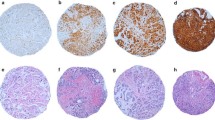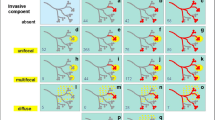Abstract
Locally advanced breast cancer (LABC) was initially characterized as a large primary tumor (≥5 cm), associated with or without skin or chest-wall involvement, fixed axillary lymph nodes, or disease spread to the ipsilateral internal mammary or supraclavicular nodes. Since 2002, LABC has been reclassified to include smaller stage IIB tumors (2 to <5 cm) with lymph node involvement, or stages IIIA–IIIB (≥5 cm) with or without nodal involvement. Despite the rather common presentation of LABC, it remains a poorly understood and highly variable clinical presentation of breast cancer that is a challenge to treatment. Here, we characterized a panel of breast tumors of known stage, grade, and key clinical–pathological parameters for the expression of the protein ezrin, which is involved in promoting signaling of the PI3K-Akt-mTOR pathway in response to extracellular and tumor micro-environmental signals, and is involved in breast cancer invasion and metastasis. We show that ezrin, which resides primarily in the apical membrane in normal breast epithelium, relocalizes primarily to the cytoplasm in >80 % of traditional (T3) invasive ductal LABC tumors (≥5 cm). Cytoplasmic ezrin is very strongly associated with a single characteristic in breast cancer—large tumor size. In contrast, in large non-malignant fibroadenomas, ezrin staining was similar to that of normal breast epithelium. Small (T1, 1 cm) invasive ductal carcinomas displayed largely apical membrane and perinuclear ezrin localization with weak cytoplasmic staining. Cytoplasmic ezrin localization was also associated with positive lymph node status, but no other clinical–pathological features, including hormone receptor status, histological or nuclear grade of tumor cell. The cytoplasmic relocalization of ezrin may therefore represent a novel marker for large malignant tumor size, reflecting the unique biology of LABC.


Similar content being viewed by others
References
Bretscher A, Edwards K, Fehon RG (2002) ERM proteins and merlin: integrators at the cell cortex. Nat Rev Mol Cell Biol 3:586–599
Fievet B, Louvard D, Arpin M (2007) ERM proteins in epithelial cell organization and functions. Biochim Biophys Acta 1773:653–660
Crepaldi T, Gautreau A, Comoglio PM, Louvard D, Arpin M (1997) Ezrin is an effector of hepatocyte growth factor-mediated migration and morphogenesis in epithelial cells. J Cell Biol 138:423–434
Wick W, Grimmel C, Wild-Bode C, Platten M, Arpin M, Weller M (2001) Ezrin-dependent promotion of glioma cell clonogenicity, motility, and invasion mediated by BCL-2 and transforming growth factor-beta2. J Neurosci 21:3360–3368
Gautreau A, Poullet P, Louvard D, Arpin M (1999) Ezrin, a plasma membrane-microfilament linker, signals cell survival through the phosphatidylinositol 3-kinase/Akt pathway. Proc Natl Acad Sci USA 96:7300–7305
Bonilha VL (2007) Focus on molecules: ezrin. Exp Eye Res 84:613–614
McClatchey AI (2003) Merlin and ERM proteins: unappreciated roles in cancer development? Nat Rev Cancer 3:877–883
Brambilla D, Fais S (2009) The Janus-faced role of ezrin in “linking” cells to either normal or metastatic phenotype. Int J Cancer 125:2239–2245
Martin TA, Harrison G, Mansel RE, Jiang WG (2003) The role of the CD44/ezrin complex in cancer metastasis. Crit Rev Oncol Hematol 46:165–186
Khanna C, Wan X, Bose S, Cassaday R, Olomu O, Mendoza A, Yeung C, Gorlick R, Hewitt SM, Helman LJ (2004) The membrane-cytoskeleton linker ezrin is necessary for osteosarcoma metastasis. Nat Med 10:182–186
Yu Y, Khan J, Khanna C, Helman L, Meltzer PS, Merlino G (2004) Expression profiling identifies the cytoskeletal organizer ezrin and the developmental homeoprotein Six-1 as key metastatic regulators. Nat Med 10:175–181
Akisawa N, Nishimori I, Iwamura T, Onishi S, Hollingsworth MA (1999) High levels of ezrin expressed by human pancreatic adenocarcinoma cell lines with high metastatic potential. Biochem Biophys Res Commun 258:395–400
Chen Z, Fadiel A, Feng Y, Ohtani K, Rutherford T, Naftolin F (2001) Ovarian epithelial carcinoma tyrosine phosphorylation, cell proliferation, and ezrin translocation are stimulated by interleukin 1alpha and epidermal growth factor. Cancer 92:3068–3075
Song J, Fadiel A, Edusa V, Chen Z, So J, Sakamoto H, Fishman DA, Naftolin F (2005) Estradiol-induced ezrin overexpression in ovarian cancer: a new signaling domain for estrogen. Cancer Lett 220:57–65
Ohtani K, Sakamoto H, Rutherford T, Chen Z, Kikuchi A, Yamamoto T, Satoh K, Naftolin F (2002) Ezrin, a membrane-cytoskeletal linking protein, is highly expressed in atypical endometrial hyperplasia and uterine endometrioid adenocarcinoma. Cancer Lett 179:79–86
Ohtani K, Sakamoto H, Rutherford T, Chen Z, Satoh K, Naftolin F (1999) Ezrin, a membrane-cytoskeletal linking protein, is involved in the process of invasion of endometrial cancer cells. Cancer Lett 147:31–38
Sarrio D, Rodriguez-Pinilla SM, Dotor A, Calero F, Hardisson D, Palacios J (2006) Abnormal ezrin localization is associated with clinicopathological features in invasive breast carcinomas. Breast Cancer Res Treat 98:71–79
Bruce B, Khanna G, Ren L, Landberg G, Jirstrom K, Powell C, Borczuk A, Keller ET, Wojno KJ, Meltzer P et al (2007) Expression of the cytoskeleton linker protein ezrin in human cancers. Clin Exp Metastasis 24:69–78
Rustogi A, Budrukkar A, Dinshaw K, Jalali R (2005) Management of locally advanced breast cancer: evolution and current practice. J Cancer Res Ther 1:21–30
Valero VV, Buzdar AU, Hortobagyi GN (1996) Locally advanced breast cancer. Oncologist 1:8–17
Greene FL, Page DL, Fleming ID, Fritz AG, Balch CM, Haller DG, Morrow M (2002) AJCC cancer staging manual. Springer, New York
Braunstein S, Karpisheva K, Pola C, Goldberg J, Hochman T, Yee H, Cangiarella J, Arju R, Formenti SC, Schneider RJ (2007) A hypoxia-controlled cap-dependent to cap-independent translation switch in breast cancer. Mol Cell 28:501–512
Wan X, Mendoza A, Khanna C, Helman LJ (2005) Rapamycin inhibits ezrin-mediated metastatic behavior in a murine model of osteosarcoma. Cancer Res 65:2406–2411
Yu Y, Davicioni E, Triche TJ, Merlino G (2006) The homeoprotein six1 transcriptionally activates multiple protumorigenic genes but requires ezrin to promote metastasis. Cancer Res 66:1982–1989
Geiger KD, Stoldt P, Schlote W, Derouiche A (2000) Ezrin immunoreactivity is associated with increasing malignancy of astrocytic tumors but is absent in oligodendrogliomas. American J Path 157:1785–1793
Weng WH, Ahlen J, Astrom K, Lui WO, Larsson C (2005) Prognostic impact of immunohistochemical expression of ezrin in highly malignant soft tissue sarcomas. Clin Cancer Res 11:6198–6204
Kobel M, Langhammer T, Huttelmaier S, Schmitt WD, Kriese K, Dittmer J, Strauss HG, Thomssen C, Hauptmann S (2006) Ezrin expression is related to poor prognosis in FIGO stage I endometrioid carcinomas. Modern Path 19:581–587
Elzagheid A, Korkeila E, Bendardaf R, Buhmeida A, Heikkila S, Vaheri A, Syrjanen K, Pyrhonen S, Carpen O (2008) Intense cytoplasmic ezrin immunoreactivity predicts poor survival in colorectal cancer. Hum Pathol 39:1737–1743
Agresti A (2002) Categorical data analysis. Wiley, New York
Elliott BE, Meens JA, SenGupta SK, Louvard D, Arpin M (2005) The membrane cytoskeletal crosslinker ezrin is required for metastasis of breast carcinoma cells. Breast Cancer Res 7(3):R365–R373
Li Q, Wu MF, Song AP, Wei JC, Xu G, Lu YP, Ma D (2006) Expression of Ezrin and E-cadherin in invasive ductal breast cancer and their correlations to lymphatic metastasis. Ai Zheng 25:363–366
Ma L, Zhang XH, Xing LX, Li YH, Wang XL, Wang YJ (2008) Relationship of ezrin protein expression to the carcinogenesis and prognosis of infitrating breast ductal carcinoma. Zhonghua Zhong Liu Za Zhi 30:279–283
Li Q, Wu M, Wang H, Xu G, Zhu T, Zhang Y, Liu P, Song A, Gang C, Han Z et al (2008) Ezrin silencing by small hairpin RNA reverses metastatic behaviors of human breast cancer cells. Cancer Lett 261:55–63
Sizemore S, Cicek M, Sizemore N, Ng KP, Casey G (2007) Podocalyxin increases the aggressive phenotype of breast and prostate cancer cells in vitro through its interaction with ezrin. Cancer Res 67:6183–6191
Acknowledgments
This research was supported by grants from the Department of Defense Breast Cancer Research Program (W81XWH-04-1-0905) and the Breast Cancer Research Foundation to SCF and RJS.
Conflict of interest
The authors declared that they have no conflict of interest.
Author information
Authors and Affiliations
Corresponding author
Additional information
Alan A. Arslan and Deborah Silvera contributed equally to this study.
Rights and permissions
About this article
Cite this article
Arslan, A.A., Silvera, D., Arju, R. et al. Atypical ezrin localization as a marker of locally advanced breast cancer. Breast Cancer Res Treat 134, 981–988 (2012). https://doi.org/10.1007/s10549-012-2017-5
Received:
Accepted:
Published:
Issue Date:
DOI: https://doi.org/10.1007/s10549-012-2017-5




